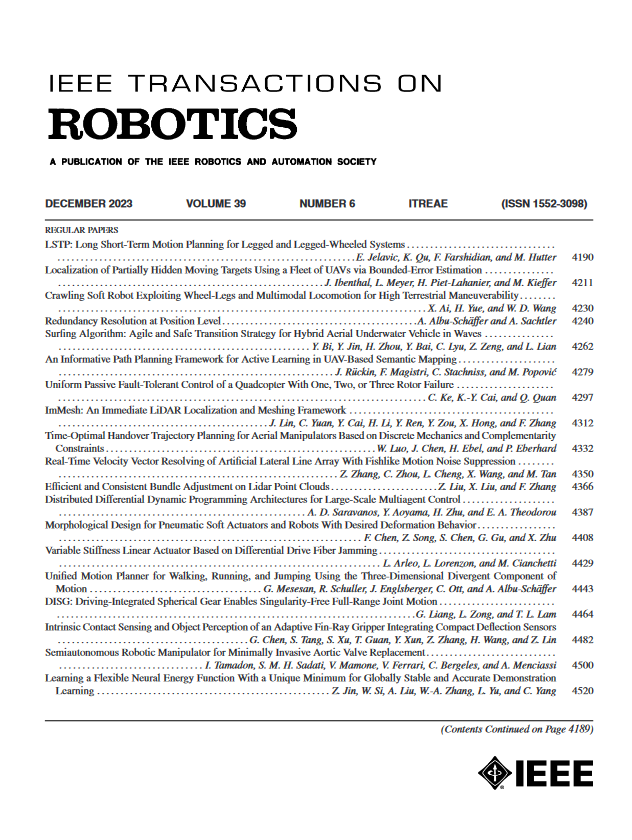Compact Modular Robotic Wrist With Variable Stiffness Capability
IF 9.4
1区 计算机科学
Q1 ROBOTICS
引用次数: 0
Abstract
We have developed a two-degree-of-freedom robotic wrist with variable stiffness capability, designed for situations where collisions between the end-effector and the environment are inevitable. To enhance environmental adaptability and prevent physical damage, the wrist can operate in a low-stiffness mode. However, the flexibility of this mode might negatively impact stable and precise manipulation. To address this, we proposed a robotic wrist that switches between a passive low-stiffness mode for environmental adaptation and an active high-stiffness mode for precise manipulation. Initially, we developed a functional prototype that could manually switch between these modes, demonstrating the wrist's passive low-stiffness and active high-stiffness states. This prototype was designed as a lightweight, flat-type modular device, incorporating a sheet-type flexure as the motion guide and embedding all essential components, including actuators, sensors, and a control unit, into the wrist module. Based on the functional prototype, we developed an improved version to enhance durability and functionality. The resulting wrist module incorporates a three-axis force/torque sensor and an impedance control system to control the stiffness. It measures 55 mm in height, weighs 200 g, and offers a 232.4-fold active stiffness variation.具有可变刚度功能的紧凑型模块化机器人手腕
我们开发了一种具有可变刚度能力的两自由度机器人手腕,设计用于末端执行器与环境之间不可避免的碰撞。为了增强环境适应性和防止物理损伤,手腕可以在低刚度模式下工作。然而,这种模式的灵活性可能会对稳定和精确的操作产生负面影响。为了解决这个问题,我们提出了一种机器人手腕,它可以在被动的低刚度模式和主动的高刚度模式之间切换,以适应环境。最初,我们开发了一个功能原型,可以手动在这些模式之间切换,展示手腕的被动低刚度和主动高刚度状态。这个原型被设计成一个轻量级的平板式模块化设备,结合了一个片状弯曲器作为运动指南,并将所有基本组件,包括致动器、传感器和控制单元嵌入到手腕模块中。在功能原型的基础上,我们开发了一个改进版本,以增强耐用性和功能性。由此产生的手腕模块包含一个三轴力/扭矩传感器和一个阻抗控制系统来控制刚度。它的高度为55毫米,重量为200克,并提供232.4倍的主动刚度变化。
本文章由计算机程序翻译,如有差异,请以英文原文为准。
求助全文
约1分钟内获得全文
求助全文
来源期刊

IEEE Transactions on Robotics
工程技术-机器人学
CiteScore
14.90
自引率
5.10%
发文量
259
审稿时长
6.0 months
期刊介绍:
The IEEE Transactions on Robotics (T-RO) is dedicated to publishing fundamental papers covering all facets of robotics, drawing on interdisciplinary approaches from computer science, control systems, electrical engineering, mathematics, mechanical engineering, and beyond. From industrial applications to service and personal assistants, surgical operations to space, underwater, and remote exploration, robots and intelligent machines play pivotal roles across various domains, including entertainment, safety, search and rescue, military applications, agriculture, and intelligent vehicles.
Special emphasis is placed on intelligent machines and systems designed for unstructured environments, where a significant portion of the environment remains unknown and beyond direct sensing or control.
 求助内容:
求助内容: 应助结果提醒方式:
应助结果提醒方式:


